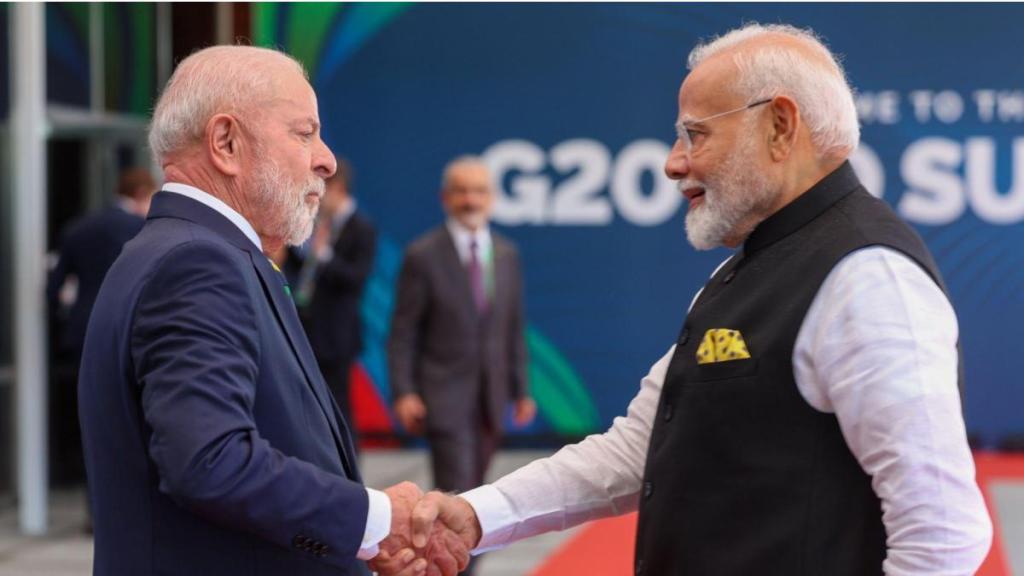Brazil’s defence strategy is undergoing a significant transformation, with the country seeking to modernize its military capabilities while also building stronger strategic alliances. At the forefront of these efforts is Brazil’s growing defence partnership with India, a key partner in the Indo-Pacific. President Luiz Inácio Lula da Silva, in his discussions with Prime Minister Narendra Modi at the just concluded G20 summit in Rio, expressed Brazil’s desire to expand bilateral cooperation across several strategic sectors, including defence, space technology, and aerospace.
During their recent meeting, the two leaders explored ways to deepen their countries’ defence ties, which have steadily expanded in recent years. As Prime Minister Modi noted after the talks, “We took stock of the full range of bilateral ties between our nations and reaffirmed our commitment to improving cooperation in sectors like defence, biofuels, agriculture, and more.” President Lula echoed this sentiment, stating, “A lot of the things we’ve been trying to do in our G20 Presidency have been inspired by the example set by India last year. We want to build upon the successes of India’s leadership in this forum.”
Modernizing Brazil’s Air Force: A Focus on Tejas
Brazil’s Air Force is in the process of modernizing its fleet, with older platforms such as the F-5 and AMX aircraft showing their age. Recently, a tragic accident involving an F-5 in Northeastern Brazil underscored the urgency of this modernization. Brazil has expressed interest in various fighter aircraft options, including F-16s from the US., Rafales from France, and India’s indigenous Light Combat Aircraft Tejas.
India’s Tejas has garnered attention due to its advanced avionics, agility, and cost-effectiveness, making it a potential solution for Brazil’s military needs. While no formal agreements have been made, there is growing interest in this indigenous Indian platform. As the Brazilian Air Force looks to replace its aging fleet, the Tejas stands out as a viable option, offering capabilities that align with Brazil’s defence priorities.
BrahMos and Akash: Enhancing Brazil’s Missile Defence
In addition to the Tejas, Brazil has also shown keen interest in several Indian-made missile systems, particularly the BrahMos and Akash missiles. The BrahMos-NG (Next Generation) supersonic cruise missile, developed through an Indo-Russian joint venture, is considered a highly capable weapon for enhancing strike capabilities. Brazil’s Gripen-E fighter aircraft, which it recently acquired, is seen as an ideal platform for integrating the BrahMos-NG, which can be launched from various platforms, including aircraft and warships.
Also
A senior defence official remarked, “For Brazil, the BrahMos-NG can be a suitable choice for their new Gripen aircraft. The new system is designed for a wide range of fighter aircraft platforms with best-in-class specifications.” The BrahMos-NG offers Brazil an advanced strike capability that complements its modernizing air force.
Brazil has also expressed interest in India’s Akash missile system, a mobile surface-to-air missile system developed by Bharat Electronics Limited (BEL). The Akash system is known for its reliability and range, making it an attractive option for Brazil as it looks to enhance its air defence infrastructure.
Strengthening Space Cooperation
India and Brazil have long cooperated in space technology, with one of the standout achievements being the launch of Amazonia-1, Brazil’s first dedicated Earth observation satellite, by India’s space agency ISRO in 2021. This collaboration helps Brazil monitor deforestation in the Amazon using India’s cutting-edge satellite technology.
The two countries are also exploring opportunities to further strengthen their space partnership, especially under the G20 Satellite Mission, which focuses on climate and environmental monitoring. Ambassador Suresh Reddy of India highlighted that, “Our space partnership is a shining example of South-South cooperation,” underscoring the importance of collaboration in addressing global environmental challenges.
C-390 Millennium: Aerospace Collaboration and Joint Ventures
Brazilian aerospace giant Embraer has developed the C-390 Millennium, a multi-role transport aircraft with impressive capabilities, including tactical and strategic airlift operations. While there is no formal quid pro quo arrangement between Brazil and India, discussions are underway regarding potential collaborations in aerospace, particularly related to the C-390.
India has shown interest in acquiring the C-390 as part of its efforts to modernize its transport fleet of the Indian Air Force (IAF). Embraer is also looking to expand its presence in India, potentially setting up an assembly line for the C-390 if the IAF opts to purchase the aircraft. Brazilian officials have expressed their willingness to explore joint manufacturing initiatives, signalling the potential for deeper industrial cooperation between the two countries.
Moreover, companies such as Companhia Brasileira de Cartuchos (CBC) and Taurus Armas have already established joint ventures with Indian firms, focused on small arms and ammunition production. These ventures are laying the groundwork for broader industrial cooperation in the defence sector.
Brazil’s Strategic Vision: Expanding Defence and Space Ties
President Lula has been vocal about his administration’s desire to deepen defence cooperation with India, with both countries exploring opportunities in key sectors such as aerospace, missile defence, and space technology. Lula underscored the importance of India’s leadership on the global stage, saying, “We want to build upon the successes of India’s leadership in G20, and strengthen our defence cooperation, as well as our space initiatives.”
This commitment to strengthening ties is reflected in the growing volume of high-level visits between the two countries. Brazil’s top military commanders have visited India, and the inaugural 2+2 dialogue between Brazil and India, held in March 2024, was a significant milestone in the bilateral relationship. As Ambassador Reddy of India put it, “Defence cooperation has become a cornerstone of our strategic relationship,” a sentiment that underscores the mutual trust and shared vision between the two nations.


